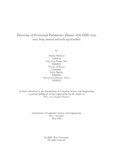| dc.contributor.advisor | Parvez, Zavid | |
| dc.contributor.author | Shahriar, Farhan | |
| dc.contributor.author | Dey, Amarttya Prasad | |
| dc.contributor.author | Rahman, Naimur | |
| dc.contributor.author | Tasnim, Zarin | |
| dc.contributor.author | Tanvir, Mohammad Zubayer | |
| dc.date.accessioned | 2021-09-14T05:33:08Z | |
| dc.date.available | 2021-09-14T05:33:08Z | |
| dc.date.copyright | 2021 | |
| dc.date.issued | 2021-06 | |
| dc.identifier.other | ID: 14201046 | |
| dc.identifier.other | ID: 16201081 | |
| dc.identifier.other | ID: 15321002 | |
| dc.identifier.other | ID: 13101154 | |
| dc.identifier.other | ID: 13321045 | |
| dc.identifier.uri | http://hdl.handle.net/10361/14999 | |
| dc.description | Cataloged from PDF version of thesis. | |
| dc.description | Includes bibliographical references (page 36-38). | |
| dc.description.abstract | Parkinson’s Disease is the second most common neurological disease after Alzheimer’s
Disease. The disease is incurable. However, if the disease can be detected earlier,
then the consequences of it’s effect can be relieved. The early phase of PD is called
by Prodromal Parkinson’s Disease. The symptoms of the Prodromal phase includes
hyposmia, constipation, mood disorders, REM sleep behavior disorder, olfaction dis orders etc. RBD or REM sleep behavior disorder is the most common symptom of
Prodromal PD. In this study, we used various deep convolutional neural network
architectures and trained them to detect Prodromal PD patients. We collected 20
Prodromal patients and 20 healthy control subject data from the PPMI website and
applied CNN architecture mobilenet v1, incception v3, vgg19 and inception resnet
v2 to achieve our goal. We ensembled inception resnet v2 and mobilenet v1 with
the hope of getting a better result as well. However, we successfully carried out
our training and with mobilenet v1 we gained the highest classification accuracy
of 81.22%. Inception resnet V2, inception v3, vgg19 and ensemble model achieved
respectively 75.30%, 62.55% and 63.32% accuracy. | en_US |
| dc.description.statementofresponsibility | Farhan Shahriar | |
| dc.description.statementofresponsibility | Amarttya Prasad Dey | |
| dc.description.statementofresponsibility | Naimur Rahman | |
| dc.description.statementofresponsibility | Mohammad Zubayer Tanvir | |
| dc.description.statementofresponsibility | Zarin Tasnim | |
| dc.format.extent | 38 pages | |
| dc.language.iso | en | en_US |
| dc.publisher | Brac University | en_US |
| dc.rights | Brac University theses are protected by copyright. They may be viewed from this source for any purpose, but reproduction or distribution in any format is prohibited without written permission. | |
| dc.subject | Convolutional Neural Network (CNN) | en_US |
| dc.subject | Parkinson’s Disease (PD) | en_US |
| dc.subject | Neural Network (NN) | en_US |
| dc.subject | fMRI | en_US |
| dc.subject | Deep Learning | en_US |
| dc.subject | Average Ensemble | en_US |
| dc.subject | VGG19 | en_US |
| dc.subject | Inception-ResNet-v2 | en_US |
| dc.subject | Inception-V3 | en_US |
| dc.subject | MobileNet-V1 | en_US |
| dc.subject | PPMI | en_US |
| dc.subject.lcsh | Deep Learning | |
| dc.title | Detection of prodromal parkinson’s disease with fMRI data and deep neural network approaches | en_US |
| dc.type | Thesis | en_US |
| dc.contributor.department | Department of Computer Science and Engineering, Brac University | |
| dc.description.degree | This thesis is submitted in partial fulfillment of the requirements for the degree of Bachelor of Science in Computer Science and Engineering, 2021. | |
| dc.description.degree | B. Computer Science | |

